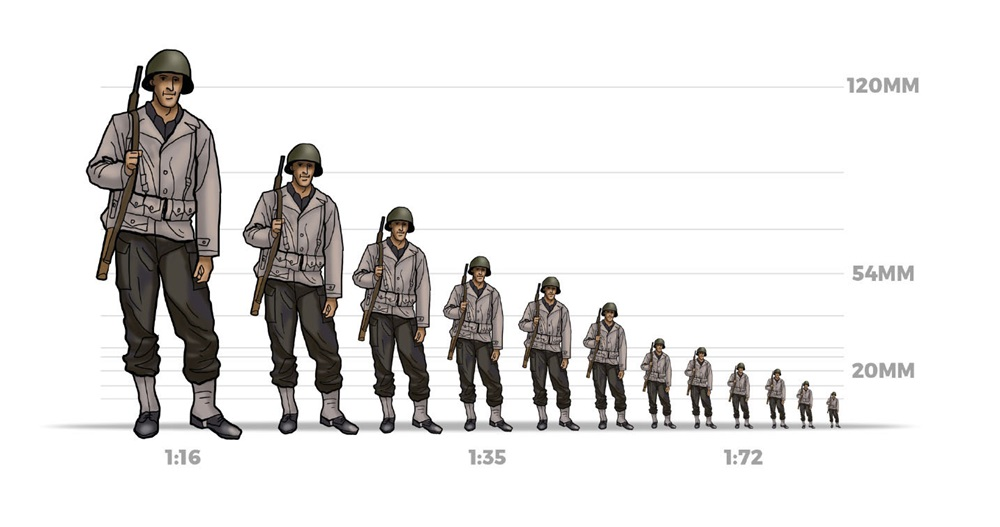A Sense of Scale
Credit: Fine Scale Modeler
From reading various forums the scale of miniatures can be a contentious issue with various inconsistencies between manufactures and hobbyists alike as to what 20 mm tall actually means (e.g. over at The Miniatures Page here).
It is also contentious as different people collect different scales, which can lead to odd looking battles when wargaming. As such there is no correct scale to pick when building a collection but different scales lend themselves to differently sized battles and rulesets. For example, Bolt Action is typically played with 28 mm miniatures but 1/56 vehicles which are technically a slightly smaller scale, please read this excellent Wargame Explorer article on the subject.
For example, a tank battle in North Africa or Kursk would be easier to show using a smaller scale (say 1/100) as it would take up less room (and cost less). Conversely, a skirmish between two squads in a ruined house could be modelled using a larger scale (say 1/35) to allow for really detailed miniatures to be used whilst still fitting on a bookshelf as a display piece.
Presented below is a brief summary of all of the major scales relevant to WWII in descending size order. Other scales do exist (for more reading see here at TMP, here at Awesome Diecast & here at Fine Scale Modeler), but I for simplicity I've limited the scope and bundled some similar scales together.
1/35 has a reasonable range of models in plastic which are moderately priced and highly detailed. This makes them an attractive choice for detailed dioramas, display pieces and games that really focus on the actions of individuals at a key moment in history.
28 mm and the similar-but-different 1/56 have a good range of models in both plastic and metal - however it is highly infantry oriented, with a reasonable number of tanks but few-to-no plane models. They are another attractive choice for detailed dioramas, but can play with both infantry and tanks on a 6' x 4' board. On that note they are the default size for many platoon sized games, namely Bolt Action produced by Warlord Games (alongside their own suitably scaled miniatures).
20 mm, 1/72 and 1/76 are all very similarly sized but are not the same size, which presents some challenges to collect them. In general 20 mm is used by wargamers and metal miniature makers to describe what vehicle model companies describe as either 1/72 or 1/76 or somewhere in between. Very old 20 mm miniatures can be much closer to 1/76 than 1/72, however most modern 20 mm miniatures are comparable to 1/72. Setting 1/76 to one side, between companies that manufacture 20 mm miniatures and those which do 1/72, this scale has the largest selection of models to choose from at affordable prices. It does come at a cost to detail, especially for the infantry models but if you want a reasonably priced selection of vehicles, tanks, planes and infantry, this might be the best option.
Note: Airfix confusingly sells 1/76 miniatures and tanks as 1/72 scale models, however their 1/72 planes are 1/72 - generally I would recommend avoiding their land models and miniatures as it isn't clear if it's 1/72 or 1/76.
15 mm and 1/100 are again similar but different sizes as per 20 mm and 1/72. (So not necessarily the same but very close and with overlap depending on manufacturer, wargamers and metal models tend to say 15 mm whereas a modelling company would say 1/100.) They are a good scale for massed tank battles, but the detail on any infantry is really lacking. This scale was used for the Flames of War rule by Battlefront Miniatures to recreate those big tank battles on the table top and who like Warlord Games manufacture their own miniatures for their game. This scale lacks planes, so Battlefront Miniatures recommend using 1/144 sized planes to fly over the battlefield.
1/144 and smaller are where ships start appearing in numbers, but this comes at the cost of infantry, then tanks and finally planes as we go down in scale. However it is really at the smaller end of things that ships can be done for a sensible cost and not take over too much space. You might have to go down to 1/400 to fit a to-scale naval engagement in your local pond!
I think all scales have a place in the discussion, and there is no wrong choices so long as you're doing this for your own enjoyment. There is also nothing wrong with doing a bit of everything, having a 28 mm army for Bolt Action when going down to your local club, a 1/35 diorama and a big 1/400 boat diorama all interesting projects in their own right and don't box yourself in to any particular scale.
That said, I'm going to initially focus on 1/72 scale, supplemented with some 20 mm miniatures where appropriate.
The next series of posts will cover the make up of a British Rifle Platoon during WWII including how to represent different nationalities and which kits to get started with.

Comments
Post a Comment